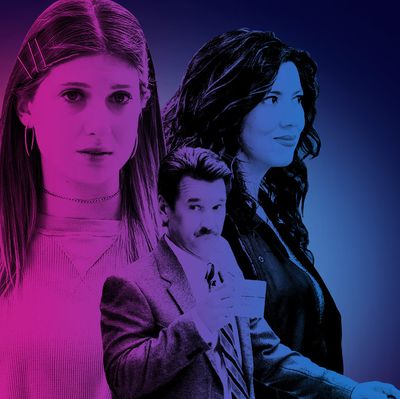
The past few months on television have seen a boom in a particular kind of story — all of a sudden, there are bisexual characters all over TV. There’s Eleanor Shellstrop low-key lusting for Tahani, and there’s the open attraction Ilana has for Abbi on Broad City. Crazy Ex-Girlfriend has Darryl and now Valencia. More recently, Brooklyn Nine-Nine’s Rosa has come out as bi and told her colleagues that she’s currently dating a woman. There was a story on Grown-ish about Zoey’s friend Nomi, who is bisexual and who dates a bisexual man. And on Jane the Virgin, after many seasons of romantic entanglements with men, Petra Solano suddenly realizes she has a powerful attraction to her lawyer, played by Rosario Dawson. It’s not the first bisexual character on the show, either — earlier this season, Jane dated Adam, who told her that he’s also dated men.
Rachel Klein wrote about how valuable the current wave of bi visibility is, how important it is to have characters who help dismantle the broad cultural misconceptions about bisexuality, and how affirming it is to watch fictional characters represent something other than a simple binary of sexual attraction. “People are complex and so are their identities,” Klein explained. “The more bisexual characters we see, the less likely we are to draw conclusions about an entire group of people based on a few examples, and the more we’ll be able to experience the full range of human experience, in art and life.”
Klein’s argument for the significance of seeing more of these characters is so important, and it’s part of a long history of similar waves of TV representation. We need to see all kinds of people in our fiction, and the more nuances and differences we can see in these characters, the less likely we are to stereotype, to assume, and to dehumanize. The more something like bisexuality is visible in our TV narratives — or trans identity, or immigration status, or going back farther, the more we see people of color, divorced couples or working mothers — the better we’re able to empathize with experiences different from ours.
I’d suggest there’s an additional reason why bisexual characters are so appealing at this moment, at least from my very selfish perspective as a TV viewer. Almost universally, the stories that these shows have found to tell about their characters coming out, about their romantic relationships, and about the mysteries of sexual attraction are more interesting than the straight stories. I have seen so, so many love triangles. I have seen so many will-they-won’t-theys that then coalesce into “they did!” and then have to find somewhere else to push the story. I have seen countless heterosexual true loves, and I’ve watched them grow into flawed but loving marriages, and I’ve loved many of them. But it is just so nice to watch love stories that explore territories outside the painfully familiar “how will that nice lady ever land a husband” world. It’s so nice to watch stories with something different to say about attraction and the complexity of adult relationships.
Take Nomi’s story on Grown-ish. She’s out as a bisexual to her friends, but not to her family. In episode five, Nomi breaks up with her boyfriend Big Dave after discovering that he’s also bi. For some reason that she cannot explain to herself, Nomi is comfortable with her own sexuality, but finds herself “freaked out” when she realizes that Dave has been with guys. Dave is baffled — after all, he met Nomi when she was on a date with a woman. “If you see two girls in bed, it’s like, not a big deal!” she tells him. “But if you see two guys in bed, it’s like… it’s weird. It’s like, ‘Where’s the other bed?’” She tells him that she knows she’s a hypocrite, but that she can’t help how she feels. And then the hammer drops. “I feel like, if you’re into guys too, how can I ever be enough for you?” “That’s not about me being bisexual,” Dave tells her. “That’s about you being insecure.”
Nomi is a bisexual woman who’s nevertheless internalized some degree of homophobia. And what’s more, even though she herself is bi, she has deeply held convictions about exactly the kind of misconceptions Klein tries to take apart in her piece (including the idea that bisexual attraction renders you incapable of monogamy). The complexity of that character is vanishingly rare on television. And yet, the possibilities someone like Nomi opens up for storytelling and character development are so broad, and feel so ripe for further exploration. Jane the Virgin took a similar tack with Jane’s boyfriend Adam, and Jane’s feelings of insecurity in dating a guy who’s also into guys. The show was able to push against Jane’s apprehension in a useful way, and to probe her unexamined assumptions about herself. A bisexual character on a TV show doesn’t just become an opportunity to tell stories about queer characters; it’s a chance to find new layers in the story’s straight characters as well.
We need as many opportunities as we can find to help us dismantle the immediate impulse to categorize people as simply one thing or another. And it’s also just so nice for long-running serial stories to open up whole new avenues for hookups. Jane the Virgin’s Petra has been so unlucky with men, and I want her to be happy! I’m so thrilled she may now have a bigger pool of potential romantic partners to explore. I’m delighted to see what it looks like for Brooklyn Nine-Nine’s Rosa to be in a committed relationship with someone other than Jason Mantzoukas. I have an advanced degree in TV love triangles, and I’m ready to graduate to some more complex geometry.


